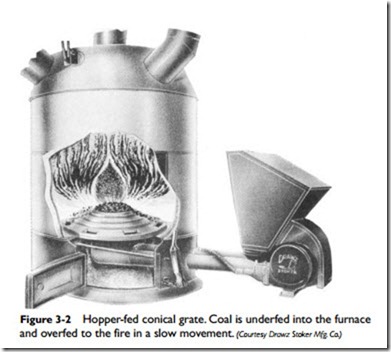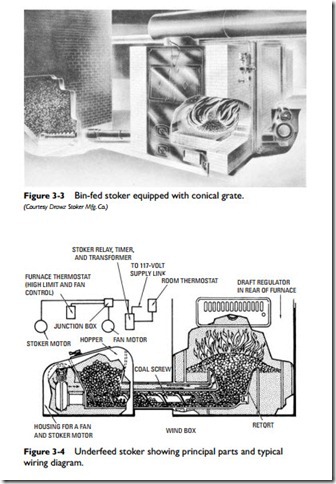Firing Semibituminous Coal
Semibituminous coal burns with far less smoke than the bituminous type. It ignites with more difficulty than bituminous coal but produces far less smoke.
The central cone method is recommended for firing semibitumi- nous coal. In this method, the coal is heaped onto the center of the bed, forming a cone, the top of which should be level with the middle of the firing door. This allows the larger lumps to fall to the sides and the fine cones to remain in the center and be coked.
The poking should be limited to breaking down the coke with- out stirring, and gently rocking the grates. It is recommended that the slides in the firing door be kept closed, as the thinner fuel bed around the sides allows enough air to get through.
Stoker Firing
A stoker is a mechanical device designed and constructed to auto- matically feed fuel to a furnace. Stokers are used in commercial, industrial, and domestic heating systems. Their use results in more efficient combustion owing to constant instead of intermittent firing.
According to the ASHRAE Guide (1960), coal stokers can be divided on the basis of their coal-burning capacity into the follow- ing four classes:
• Class 1 stokers (10 to 100 lbs per hour)
• Class 2 stokers (100 to 300 lbs per hour)
• Class 3 stokers (300 to 1200 lbs per hour)
• Class 4 stokers (over 1200 lbs per hour)
Class 1 stokers are used most commonly in domestic heating installations. The other three classes of stokers are used in commercial and industrial heating systems.
Class 1 stokers are usually the underfeed type and are designed to burn anthracite, bituminous, semibituminous, and lignite coal, and coke. Ash can be removed automatically or manually, with the latter method being the most popular.
Stokers can also be classified on the basis of whether the coal is stored in a hopper or bin. The disadvantage of the hopper design (see Figure 3-2) is that it must be refilled at least once each day. The bin stoker design (see Figure 3-3) eliminates coal handling. The coal is delivered by the supplier and placed directly into the bin.
The underfeed stoker (see Figure 3-4) is generally used for house heating furnaces and boilers. This type of stoker is one in which the
fuel is fed upward from underneath the furnace or boiler. The action of a screw or worm carries the fuel back through a retort from which it passes upward as the fuel above is being consumed. The ash is generally deposited on dead plates on either side of the retort, from which it can be removed.
Underfeed stokers can be designed for use with either anthracite or bituminous coal, but the individual pieces of coal should be uni- form in size and no larger than 1 inch in diameter. As mentioned elsewhere in this chapter, it is desirable to treat the coal with oil in order to eliminate dust. The worm feed mechanism can be regu- lated to feed coal at variable rates.

